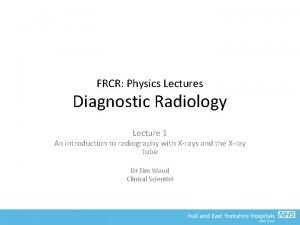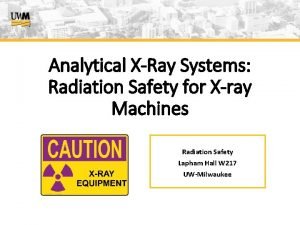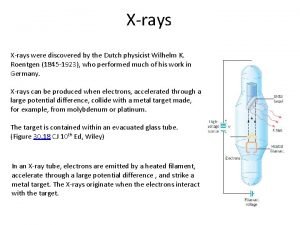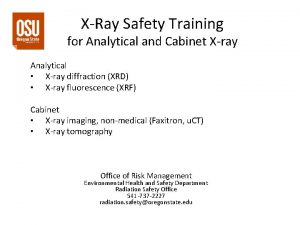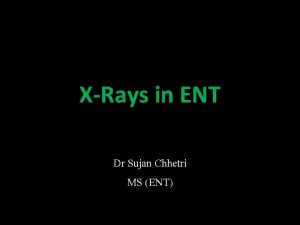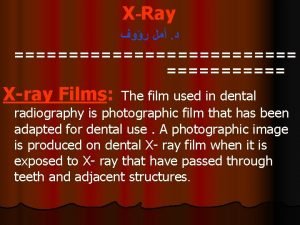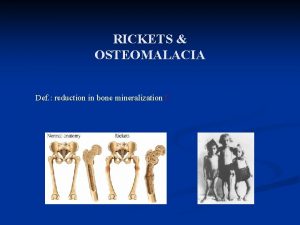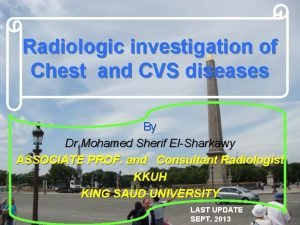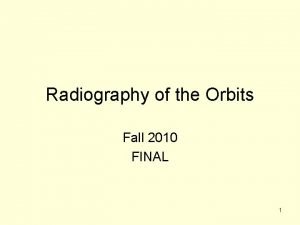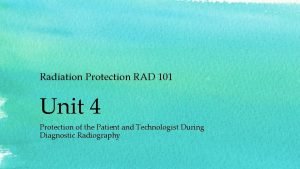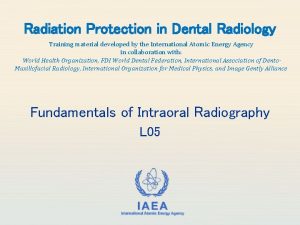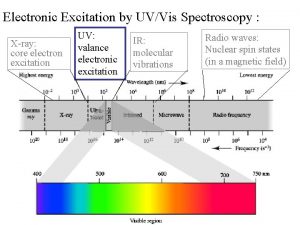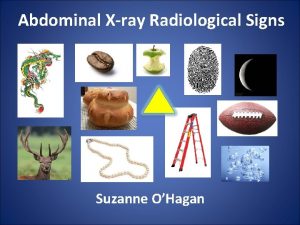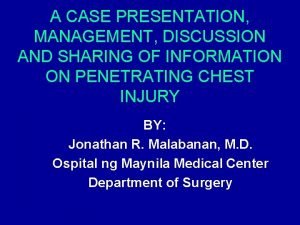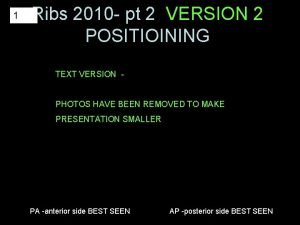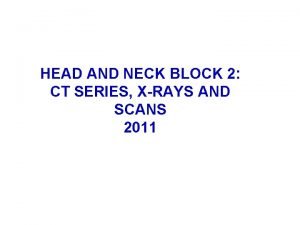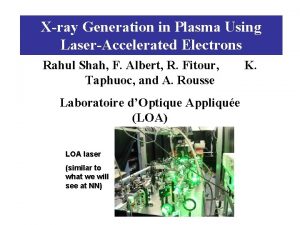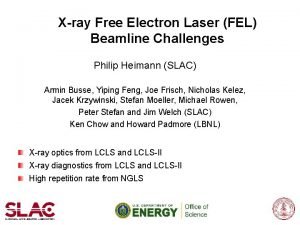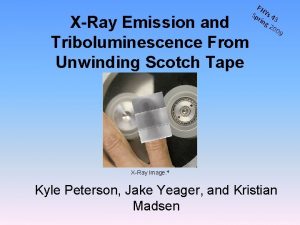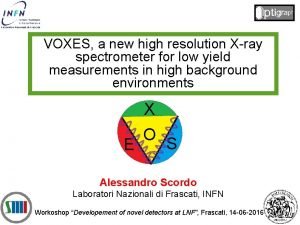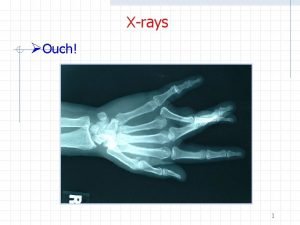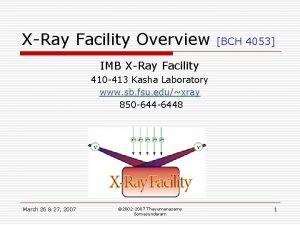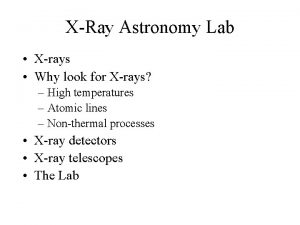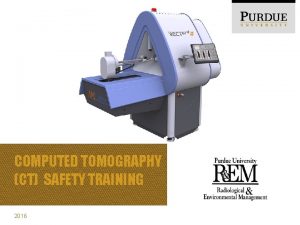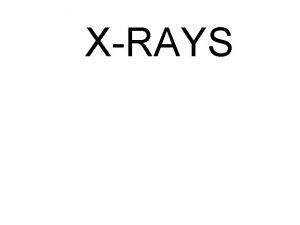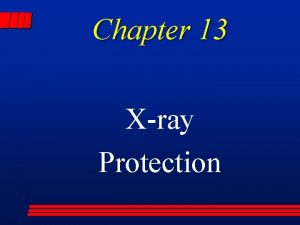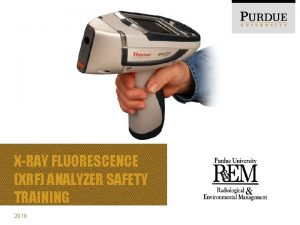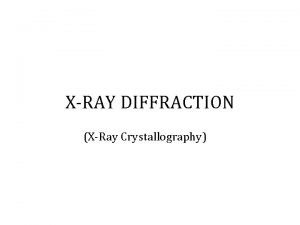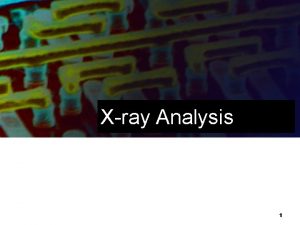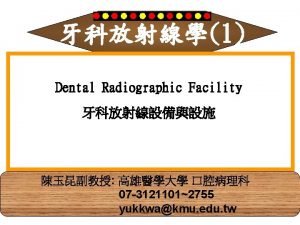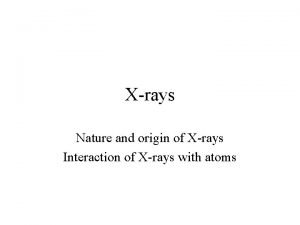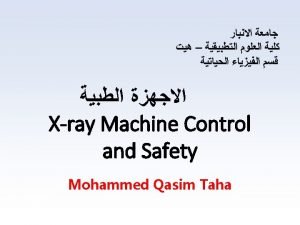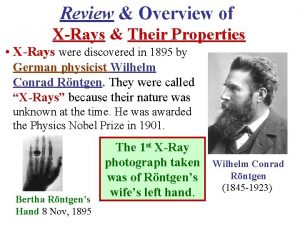PHENOTYPING FACILITY XRAY SAFETY TRAINING 2019 XRAYS Xrays










































- Slides: 42

PHENOTYPING FACILITY XRAY SAFETY TRAINING 2019

X-RAYS • X-rays are a type of ionizing electromagnetic radiation. • X-rays are a valuable tool, but there associated health risks. • These risks can be minimized by adhering to certain principles and practices as explained in this presentation. • X-rays are capable of traveling great distances and penetrating through lowdensity materials such as wood and plastic. • However, they can be blocked or attenuated by shielding made from highdensity materials such as lead and concrete.

X-RAY SHIELDING While all materials absorb X-rays, dense materials such as lead, steel and concrete are the most effective. Hence, they are the preferred shielding materials.

X-RAY PRODUCTION (1) • • • X-rays are generated in the X-ray tube of the device. Electrons, that have been accelerated using a high voltage source, are abruptly decelerated by striking a metal target (e. g. , copper, molybdenum, and tungsten). Some of the energy of the electrons that impinge upon the target are converted into X-rays.

X-RAY PRODUCTION (2) • • X-ray production is proportional to operating potential (k. Vp) and current (m. A) When the X-ray unit is not operating or it is powered down, the high voltage is not applied and X-rays are not produced. Therefore, there is no danger present when the machine is not operating or it is powered down. For certain X-ray devices, the devices usually idle at low power instead of powering down

BIOLOGICAL EFFECTS, DOSE LIMITS AND RADIATION SAFETY PRINCIPLES

DOSE • When radiation interacts with living material such as our bodies, they may deposit enough energy to cause biological damage. Biological damage can occur as a result of chemical bonds being broken, DNA damage, and cells being damaged or killed. • Radiation induced health effects are dependent on radiation dose. • The ‘rem’ is the common unit of dose in the U. S. • 1 rem = 1000 millirem (mrem) • The ‘sievert’ is the common international unit of dose. • 1 sievert = 100 rem

HEALTH EFFECTS OF RADIATION EXPOSURE • Health Effects from exposure to radiation range from no effect at all to death, including diseases such as cancer. • The health effects can be divided into two categories: 1. Early Effects 2. Delayed Effects

EARLY EFFECTS (1) • Occur shortly after exposures resulting in large doses (>100 rem), delivered within a short time period (acute exposure) • Acute exposures cause extensive biological damage to cells so that large numbers of cells are killed. • The severity of the health effects is proportional to the dose. • Possible health effects include: vomiting, diarrhea, skin burns, cataracts, hair loss, fever, lethargy, loss of appetite, changes in blood count, and death.

EARLY EFFECTS (2) • An estimated dose of around 325 rem for young healthy adults without medical intervention will result in death to 50% of the group within 60 days. • For a dose of less than about 800 rem, an exposed person is likely to survive with appropriate hospital care. • Under normal operation, the occurrence of early effects is not possible.

DELAYED EFFECTS • Occur years after acute and chronic (low doses over a long time period) exposures. • Possible health effects include: leukemia, cancer, life span shortening, cataracts, and genetic defects.

DELAYED EFFECTS - GENETIC EFFECTS • Radiation studies involving fruit flies and mice suggest the possibility of heritable genetic effects in humans if there is radiation damage to the cells of the sperm or eggs. • These effects may show up as genetic defects in the children of exposed individuals and succeeding generations. • Scientists have studied populations of individuals exposed to radiation (e. g. , atomic bomb survivors and radiation workers) to identify the presence of heritable genetic effects. • To date, no heritable genetic effects from radiation have ever been observed in any human population exposed to doses ranging from natural background to that received by atomic bomb survivors.

DELAYED EFFECTS – STOCHASTIC • Leukemia, cancer, and genetic effects are considered stochastic effects; the probability of occurrence is dependent of dose. • As dose increases, the probability of occurrence increases. • Conservative studies estimate a 0. 04% increase of developing an adverse health effect per rem received. • For additional information, refer to Regulatory Guide 8. 29

GOVERNMENT DOSE LIMITS • In an effort to reduce the risk of potential health effects caused by radiation, the Indiana State Department of Health (ISDH) has set dose limits for those working with radiation producing devices. • These limits are put in place to create an upper limit of how much radiation a worker is allowed to be exposed to within a certain time period. • Individuals who stay below the dose limits: • Will not develop any early effects. • Will maintain a very small risk of developing delayed effects. 14

DOSE LIMIT VALUES The ISDH has permitted Purdue University to use Nuclear Regulatory Commission (NRC) dose limits. NRC Dose Limits (10 CFR 20. 1201) Section of Body Limit (rem) Whole Body (Head, torso and organs) 5 Lens of the Eye 15 Extremities (Hands, forearms, feet and ankles) 50 15

RADIATION & PREGNANCY (1) • Epidemiological studies of the A-bomb survivors, pregnant women who received pelvic X-rays, and animal studies indicate that embryos and fetuses are extremely radiosensitive. • The principle effects of radiation on the developing embryo and fetus, are embryonic, fetal, or neonatal death; congenital malformations; growth retardation; and functional impairment, such as mental retardation; and cancer. • The effects depend on the stage of gestation, the dose, and the dose rate. • These occurrences are extremely unlikely at Purdue because the doses possible from normal operation are very low.

RADIATION & PREGNANCY (2) • Pregnant individuals should take all precautions possible to keep exposures to the embryo or fetus as low as possible. • Extra precautions are taken by Purdue University for a Declared pregnant woman. • Declared pregnant woman means a woman who has voluntarily informed Purdue, in writing, of her pregnancy and the estimated date of conception. • If a declaration is made, it must be given to the Radiation Safety Officer (RSO) in writing.

RADIATION & PREGNANCY (3) • Once in effect, the pregnant worker’s exposure limit will be reduced to 10% of the occupational dose limit. • In addition, that worker will be given a fetal dosimeter to monitor the dose received by the embryo or fetus. • The declaration remains in effect until the declared pregnant woman withdraws the declaration in writing or is no longer pregnant. • For additional information, refer to Regulatory Guide 8. 13 18

ALARA • • The risk of developing delayed effects can be decreased by decreasing dose. Scientists accept the linear no-threshold theory which states that even low-doses carry some risk of developing delayed effects. The goal is not only to remain below the dose limits, but to keep it even lower by trying to keep doses As Low As Reasonably Achievable (ALARA). ALARA is not just a good idea, it is REQUIRED by law (410 IAC 5 Rule 4).

ALARA PRINCIPLES • There are several practices that will help you to keep your dose As Low As Reasonably Achievable (ALARA). • Time: Decreasing the time spent in a radiation area results in a lower accumulated dose. Plan work efficiently to avoid spending too much time near X-ray equipment. • Distance: The greater the distance between you and the X-ray unit, the lower the dose. • Shielding: The greater the shielding, the lower the dose. Lead and concrete works well to attenuate X-rays.

X-RAY DEVICE SAFETY FEATURES, EXPOSURE PATHWAYS AND SAFE PRACTICES

EXPOSURE PATHWAYS Radiation doses result from the following exposure pathways • Primary Beam – The useful X-ray beam (orange arrows) emitted by the device used to analyze the sample • Leakage Radiation • X-rays (green arrows) that escape the tube housing • Low energy X-rays (blue arrows) that escape the shielded cabinet

SAFETY FEATURES – TUBE HOUSING X-ray Tube Housing – The X-ray tube is enclosed in a shielded housing. Only the primary beam and low levels of leakage radiation permitted to escape the housing • This greatly reduces the dose to surrounding individuals • Regulations limit the dose within 5 cm of the tube housing to 2. 5 mrem in one hour

SAFETY FEATURES – SHUTTER Shutter – A Mechanical device that controls the emission of X-rays out of the tube housing • X-rays are emitted when the shutter is open • X-rays are not emitted when the shutter is closed

SAFETY FEATURES – PRIMARY BARRIER Primary Barrier – Provides shielding from the primary beam. Two primary barriers integrated into the device • The detector array (yellow arrow) • Lead plate (not seen) located behind the detector array

SAFETY FEATURES – SHIELDED CABINET Shielded Cabinet – A physical cabinet (includes the doors) that absorbs a significant fraction of low-energy X-rays that would otherwise escape. The cabinet also prevents parts of the body from entering the primary X-ray beam • Regulations limit the dose within 5 cm of the cabinet to 0. 25 mrem in one hour • ALARA principles of time and distance must still be followed

SAFETY FEATURES – INTERLOCKS Interlocks – Safety switches that prevent access to the primary beam. • When the door is open, interlocks prevent the shutter from opening • If door is opened during imaging, the interlocks will cause the shutter to close

SAFETY FEATURES – WARNING SIGNALS Warning Light – Indicates that X-rays are being produced. • These are failsafe, meaning X-rays will not be produced if the light is not operational • There are two warning lights, one on each side of the device, located on the top corners. Audible Horn – Warn individuals inside the device that X-rays will begin generating, providing individuals sufficient time to hit emergency stop 28

SAFETY FEATURES – EMERGENCY STOP Emergency Stop – A mechanical button that, when pressed, will instantly turn off the X-ray tube.

RADIATION AREA MONITOR Radiation Area Monitor – A device that continuously monitors the radiation field. Designed to emit an audible alarm if an abnormal event occurs (i. e. doors fail to close and X-ray emitted)

EMERGENCY PROCEDURES If the radiation area alarms, the device malfunctions or any other abnormal event occurs, do the following: • Turn off the X-rays by pressing the stop button (yellow arrow) on the control software • When off, the status will read, ‘X-ray off’ • This is the preferred way to stop production of X-rays • If this fails, press the emergency stop button • Not the preferred way to stop the production of X-rays

LOCKOUT AND TAGOUT When performing maintenance, troubleshooting, repair and servicing that involves working inside the shielded cabinet, the device must be turned off and the power supply must be locked out or tagged out

ACCESS REQUIREMENTS The following requirements must be met before you are authorized to use the X-ray device: • Permission from the supervisor responsible for the X-ray device • Completion of REM’s X-ray safety training (this training presentation) • Submit completed A-4 form to REM • Specific training from the supervisor for the operation of the X-ray device. • Any additional requirements deemed necessary by the supervisor.

ENFORCEMENT Failure to comply with the rules, regulations safe practices established by Indiana State Department of Health or Purdue University can result : • Re-training • Loss of work privileges with X-ray producing devices • Obtaining an injunction or court order to prevent a violation • Civil penalties • Criminal penalties • For willful violation of, attempted violation of or conspiracy to violate any regulation 34

SECURITY Only the individuals that are listed as Approved Authorized Users on the specific X-ray project as defined by REM may have the ability to operate the X-ray unit(s). • Lab should be locked when not attended by authorized users. • Any additional security requirements deemed necessary by the supervisor. • If an unauthorized user is found using the unit, immediately notify the Supervisor/PI. REM should be contacted to schedule a training for the user in order for them to become authorized. • It is important for all those using the X-ray equipment to be: • Trained on the specific unit • Trained on X-ray awareness in order to be informed of safety requirements, hazards involved and ways to prevent unnecessary exposures 35

REGULATIONS AND REM

STATE REGULATIONS The Indiana State Department of Health (ISDH) regulates the use of X-ray equipment in Indiana through Title 410 Indiana Administrative Code Article 5: Radiological Health. 410 IAC 5 Rule 2: Registration of Radiation Machine Facilities and Services. • 410 IAC 5 Rule 4: Protection and Exposure Standards. • 410 IAC 5 Rule 5: Non-Medical Radiography (includes X-ray fluorescent lead based analyzers). • 410 IAC 5 Rule 6. 1: X-rays in the Healing Arts. • 410 IAC 5 Rule 8: Radiation Safety Requirements for Analytical X-Ray Equipment. • 410 IAC 5 Rule 9: Radiation Safety Requirements for Particle Accelerators. • 410 IAC 5 Rule 10: Notices, Instructions and Reports to Workers; Inspections. 37

UNIVERSITY ORGANIZATION • • • The radiation safety program is empowered by Purdue University Executive Memorandum No. B-14 Purdue University’s radiation policies can be found in the Purdue Radiation Safety Manual The radiation safety program is managed by the: • Radiation Safety Committee (RSC) • Ensures the safety of the University and community in the utilization of all radioactive materials and radiation producing devices at the University or by University faculty, staff or students. • Department of Radiological and Environmental Management (REM) • Carries out the directives of the RSC. 38

REM RESPONSIBILITIES REM is responsible for: • Performing a radiation survey and compliance inspection when X-ray equipment is first installed, and when equipment is relocated or altered in any way that affects radiation safety. • Performing an annual survey and inspection of each X-ray machine. • When necessary, providing dosimetry to monitor radiation dose of users • Providing X-ray safety training for X-ray users. • REM is also responsible for complying with regulations set forth by the ISDH, for the safe use of radiation producing devices such as X-ray units. • This is accomplished by providing training, calibration services, personnel dosimetry to monitor radiation exposure and consulting support for any safety issues identified by Purdue University employees and students. 39

CONTACT REM IF… • You know or suspect there has been an exposure to an individual • The X-ray unit is to be moved or modified • Personnel working on the project has been changed (added/dropped) 40

RADIATION SAFETY GROUP • James Schweitzer, Ph. D. Radiation Safety Officer (RSO) 49 -42350 jfschweitzer@purdue. edu • Matthew Tang Health Physicist 49 -42721 mmtang@purdue. edu • Kyle Smith Health Physicist 49 -41478 smith 514@purdue. edu • Jerry J. Gibbs Waste Handling & Meter Calibration 49 -40207 jjgibbs@purdue. edu 41

END OF TRAINING MODULE • • • This concludes the Power. Point portion of the training. Complete the test indicated below. You must have 75% of correct responses to pass. • Your results will be emailed to you, and will constitute as your certification of your successful completion of the online portion of your training, if you have passed. Submit a completed Form A-4 (make sure that both you AND your Principal Investigator have signed the form), and send through campus mail to: ANCA CONDRET/REM/HAMP Click here to begin the test.
 High throughput phenotyping
High throughput phenotyping Heel effect
Heel effect Who discovered xrays
Who discovered xrays Jfk skull
Jfk skull How were xrays discovered
How were xrays discovered Xray training
Xray training Safety care certification
Safety care certification Acute retropharyngeal abscess
Acute retropharyngeal abscess Identification dot on x-ray film
Identification dot on x-ray film Plain film kub
Plain film kub Xray xml editor
Xray xml editor Sza xray
Sza xray Mary beth sanders
Mary beth sanders Rickets def
Rickets def Cvs chest x ray
Cvs chest x ray Rhese orbit x ray
Rhese orbit x ray Crista gali
Crista gali Xray technique chart
Xray technique chart Faulty radiographs
Faulty radiographs Falling load generators
Falling load generators Xray lara
Xray lara Double exposure xray
Double exposure xray Double bond extending conjugation
Double bond extending conjugation 5 cyanotic congenital heart disease
5 cyanotic congenital heart disease The “doge’s cap” sign
The “doge’s cap” sign Noi toi poi doi
Noi toi poi doi Oblique ribs xray
Oblique ribs xray Xray file cabinet
Xray file cabinet Gimp xray
Gimp xray Single door dark room
Single door dark room Hampton hump xray
Hampton hump xray First xray ever taken
First xray ever taken Pterigoid plate
Pterigoid plate Xray laser
Xray laser Xray laser
Xray laser Triboluminescence scotch tape
Triboluminescence scotch tape Xray laser
Xray laser Xray spectrometer
Xray spectrometer Xray laser
Xray laser Xray laser
Xray laser Haustra xray
Haustra xray Xray laser
Xray laser Xray laser
Xray laser

